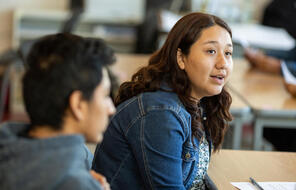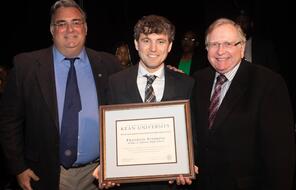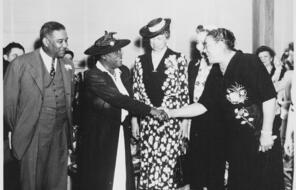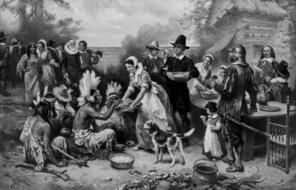
Guide to Graduate Credit for Facing History's Online Courses
Table of Contents
Section 2: Graduate Credit Requirements
- Course Participation
- Development of a Facing History & Ourselves Curriculum Unit Project
- Final Project Components
Section 3: Grading Rubric for Graduate Credit Participants
Section 1: Registration
Facing History is partnering with the University of Colorado Colorado Springs (UCCS) to offer graduate credit for several online courses as part of the UCCS Graduate Certificate Program in Diversity, Social Justice and Inclusion.
Credit Hours: 3 graduate credits
Graduate Credit Registration Deadline: One week after course start date
Tuition Paid to UCCS: $516 tuition + additional program fees
Note: All financial transactions for graduate credit tuition and program fees and requests for transcripts after the course take place between you and UCCS. Facing History and your facilitator will be given the names of those taking the course for graduate credit and will communicate with you about your additional project detailed below. If you have questions about tuition and transcript requests, contact Brian Glach at bglach [at] uccs.edu.
Fee Paid to Facing History: $75 administration fee (Note: This fee will be billed to you by Facing History after we receive a roster of the course registrants from UCCS, by the end of week two of the course.)
To Register for Graduate Credit:
- Register for your online course. You can find the listing on the Upcoming Courses & Seminars page.
- Register for graduate credit on the UCCS website.
- If you have not already applied to the Extended Studies Program and activated your myUCCS student portal account, download the application/registration instructional packet.
- If you have taken previous courses through UCCS, go directly to the portal login page at www.uccs.edu/~portal.
- Once you log in to the portal, select your course. You can search for this course by using the title of the course or selecting “Facing History” as the provider.
Section 2: Graduate Credit Requirements
Course Participation (60% of grade)
Graduate credit participants are expected to fully participate in all aspects of the online course each week. This includes completing assigned readings and activities and participating in all online discussions. Participation in the course webinar(s) and completion of an evaluation at the conclusion of the course are also required.
During each session of the online course, graduate credit participants are expected to review the course’s corresponding Facing History study guide and other relevant resources (i.e If you are taking the online course A New Approach to Teaching To Kill a Mockingbird, you are expected to read the Teaching Mockingbird resource guide and the novel, To Kill a Mockingbird).
While reading, graduate credit participants should make note of the elements of the guide and novel that they would like to use in their teaching/unit, including:
- Essential questions (1 or 2)
- Classroom activities (1 or 2)
- Chapter questions (4 or 5, where applicable)
- Section questions (2 or 3, where applicable)
- Historical or nonfiction sources (film and text, 2 or 3, where applicable)
These selections can then be used when you turn to creating your final curriculum unit at the end of the course. Space for planning notes can be found in the course planner, an editable PDF available for download from the “Course Objectives and Resources” module.
Development of a Facing History & Ourselves Curriculum Unit Project (40% of grade)
Graduate credit participants in our online courses will create an individual final project that is due within two weeks of the end of the course. The final project consists of the following three components:
- Curriculum unit
- Detailed lesson plan
- Personal reflection
The goals of this final project are to:
- Demonstrate understanding of Facing History & Ourselves’ approach, including our pedagogy and scope and sequence
- Create a lesson plan that reflects participants’ learning in the online course as well as the needs of students and individual goals in the classroom
- Facilitate participants’ reflection on their learning in the online course and to help them articulate insights that may enhance their classroom practice more broadly
Important Notes
Due Date: Final projects are due within two weeks of the conclusion of the online course.
"Live" Learning Presentation: During a synchronous "live" learning opportunity near the end of the course, graduate credit participants will be asked to share an idea, question, or work product related to their unit. This does not need to be a completed lesson or activity; it can be a work in progress. Graduate credit participants should be prepared to briefly share and discuss (3-5 minutes) their idea, question, or work product.
Reminder: Your course facilitator is also your coach through the graduate credit work and is available for questions or to provide feedback at the early stages of your project. Do not hesitate to reach out and communicate any concerns or questions.
Final Project Components (Select your course from the list below)
A New Approach to Teaching To Kill a Mockingbird Final Project Components
- A curriculum unit outline, between 4 and 12 weeks long, that follows the Facing History scope and sequence and provides a path through the novel (approximately 12–20 pages)
- This unit outline on To Kill a Mockingbird should use the Facing History pedagogical framework (also known as scope and sequence) to structure the progression of the unit. Typically, a full scope and sequence unit ranges from four to eight weeks in length. If needed, example lesson plan formats can be found on our Educator Resources page.
- Participants are encouraged to use what they gathered during the course and may also draw from the Teaching Mockingbird resources. Think of the elements of the Teaching Mockingbird guide as ingredients, and then put them together to make a customized recipe for teaching To Kill a Mockingbird to your students.
- Include the following in your unit outline:
- A description of your school, class demographics, and intended grade level
- Curricular and pedagogical context for the unit (for example, what are the themes/essential questions of the unit/course, and what directly precedes and what directly follows the unit of study?)
- A short rationale for the resources being used and for the themes/essential questions the class will explore
- Essential questions, classroom activities, chapter/section questions, and historical documents selected from the guide
- Reflection on the Facing History & Ourselves Teaching Mockingbird guide as an integral part of building the unit, evident in the specific readings chosen
- Examples of pedagogies used or discussed during the online course, highlighted and described with references to specific content; teaching strategies should also be included
- Linkages to the district, state, or Common Core standards appropriate to the discipline(s) used for the unit
- Examples of assessments to be used
- Creative use of resources that create opportunities for interdisciplinary work
- One fully-developed exemplar lesson (approximately 3–6 pages)
- The lesson should focus on one to three days of teaching within your unit and provide a detailed description of an aspect of your unit outline.
- Include the following in your exemplar lesson:
- A pairing of a moment in the novel with one or more historical sources (resources can be from the Teaching Mockingbird guide or other sources)
- Objectives, resources, and a detailed procedure
- Information on how it will be assessed by the teacher
- Personal reflection (approximately 2–4 pages)
- The personal reflection essay should document your own thinking and learning in response to the essential question for the guide: What factors influence our moral growth? What kinds of experiences help us learn to judge right from wrong
- Participants can write about how both the novel and their experience in the course have shaped their response to that question and also reflect on how they could apply these insights in their classroom.
- Participants can include excerpts from their online course discussion and journal entries from their planner for reflection.
- The personal reflection essay should document your own thinking and learning in response to the essential question for the guide: What factors influence our moral growth? What kinds of experiences help us learn to judge right from wrong
A New Approach to the Reconstruction Era Final Project Components
- A curriculum unit outline, between 4 and 12 weeks long, that follows the Facing History scope and sequence (approximately 12–20 pages)
- This unit outline on the Reconstruction Era should use the Facing History pedagogical framework (also known as scope and sequence) to structure the progression of the unit. Typically, a full scope and sequence unit ranges from four to eight weeks in length. If needed, example lesson plan formats can be found on our in our resource library.
- Participants are encouraged to use what they gathered during the course and may also draw from The Reconstruction Era and the Fragility of Democracy resources. Think of the elements of the The Reconstruction Era and the Fragility of Democracy unit as ingredients, and then put them together to make a customized recipe for teaching the Reconstruction era to your students.
- An overview of the curriculum unit, to include the following:
- A description of the school and class demographics; intended grade level.
- Curricular and pedagogical context for the unit. For example, what are the themes/essential questions of the unit/course, what directly precedes and what directly follows the unit of study?
- A rationale for the resources being used and for the themes/essential questions the class will explore.
- A short reflection of how the online course has influenced your curriculum and thinking about this topic.
- The Facing History & Ourselves unit, The Reconstruction Era and the Fragility of Democracy, should be an integral part of building the unit and be reflected in the specific lessons, readings, and handouts chosen.
- Examples of pedagogies used or discussed during the online course should be highlighted and described in detail with references to specific content. Teaching strategies should be included as well.
- Links to local, state, or national frameworks appropriate to the discipline(s) used for the unit.
- Examples of assessments to be used.
- Creative use of resources that create opportunities for interdisciplinary work.
- Each section of the Facing History scope and sequence must be included in the curriculum unit:
- Identity
- Membership (We and They)
- History
- Judgment, Memory and Legacy
- Choosing to Participate
- (Optional) You may also reference how you are thinking about the pedagogical triangle in your unit.
- Each of the sections of the scope and sequence will include the following information and description:
- Background Information
- Essential Questions
- Key Content Themes
- Materials and Resources (such as text, video, web)
- Benchmark Activity (classroom-based activity)
- Links to Standards and Frameworks
- One fully-developed exemplar lesson (approximately 3–6 pages)
- The lesson should focus on one to three days of teaching within your unit and provide a detailed description of an aspect of your unit outline. Include the following in your exemplar lesson:
- Objectives, resources, and a detailed procedure
- Information on how it will be assessed by the teacher
- The lesson should focus on one to three days of teaching within your unit and provide a detailed description of an aspect of your unit outline. Include the following in your exemplar lesson:
- Personal reflection (approximately 2–4 pages)
- The personal reflection essay should document your own thinking and learning in response to this prompt: What parts of the history will resonate most with your students? What details and nuances in the history can you share with your students to help them better understand the lesson’s documents and think more deeply about the moral and ethical dilemmas they encounter?
- Participants can write about their experience in the course have shaped their response to that question and also reflect on how they could apply these insights in their classroom.
- Participants can include excerpts from their online course discussion and journal entries from their planner for reflection.
- The personal reflection essay should document your own thinking and learning in response to this prompt: What parts of the history will resonate most with your students? What details and nuances in the history can you share with your students to help them better understand the lesson’s documents and think more deeply about the moral and ethical dilemmas they encounter?
Holocaust and Human Behavior Final Project Components
For educators taking Holocaust and Human Behavior and Holocaust and Human Behavior for Educators in a Jewish Setting.
- A curriculum unit outline, between 4 and 12 weeks long, that follows the Facing History scope and sequence (approximately 12–20 pages)
- This unit on Holocaust and Human Behavior should use the Facing History pedagogical framework (also known as scope and sequence) to structure the progression of the unit. Typically, a full scope and sequence unit ranges from four to eight weeks in length. If needed, example lesson plan formats can be found in our our resource library.
- Participants are encouraged to use what they gathered during the course and may also draw from Holocaust and Human Behavior resources. Think of the elements of the Holocaust and Human Behavior resource guide as ingredients, and then put them together to make a customized recipe for teaching about the Holocaust and Human Behavior.
- An overview of the curriculum unit, to include the following:
- A description of the school and class demographics; intended grade level.
- Curricular and pedagogical context for the unit. For example, what are the themes/essential questions of the unit/course, what directly precedes and what directly follows the unit of study?
- A rationale for the resources being used and for the themes/essential questions the class will explore.
- A short reflection of how the online course has influenced your curriculum and thinking about this topic.
- The Facing History & Ourselves resource book, Holocaust and Human Behavior, should be an integral part of building the unit and be reflected in the specific lessons, readings, and handouts chosen.
- Examples of pedagogies used or discussed during the online course should be highlighted and described in detail with references to specific content. Teaching strategies should be included as well.
- Links to local, state, or national frameworks appropriate to the discipline(s) used for the unit.
- Examples of assessments to be used.
- Creative use of resources that create opportunities for interdisciplinary work.
- Each section of the Facing History scope and sequence must be included in the curriculum unit:
- Identity
- Membership (We and They)
- The Holocaust
- Judgment, Memory and Legacy
- Choosing to Participate
- (Optional) You may also reference how you are thinking about the pedagogical triangle in your unit.
- Each of the sections of the scope and sequence will include the following information and description:
- Background Information
- Essential Questions
- Key Content Themes
- Materials and Resources (such as text, video, and web)
- Benchmark Activity (classroom-based activity)
- Linkages to Standards and Frameworks
- One fully-developed exemplar lesson (approximately 3–6 pages)
- The lesson should focus on one to three days of teaching within your unit and provide a detailed description of an aspect of your unit outline. Include the following in your exemplar lesson:
- Objectives, resources, and a detailed procedure
- Information on how it will be assessed by the teacher
- The lesson should focus on one to three days of teaching within your unit and provide a detailed description of an aspect of your unit outline. Include the following in your exemplar lesson:
- Personal reflection (approximately 2–4 pages)
- The personal reflection essay should document your own thinking and learning in response to this prompt:
- What parts of the history will resonate most with your students?
- What details and nuances in the history can you share with your students to help them better understand the lesson’s documents and think more deeply about the moral and ethical dilemmas they encounter?
- Participants can write about their experience in the course have shaped their response to that question and also reflect on how they could apply these insights in their classroom.
- Participants can include excerpts from their online course discussion and journal entries from their planner for reflection.
- The personal reflection essay should document your own thinking and learning in response to this prompt:
Helpful Tips for Developing the Curriculum Unit
- Your facilitator will set up a time to review the graduate credit assignment requirements. This will be an opportunity to ask questions and hear from others taking the course for graduate credit.
- Review resources and lessons in our online resource library. The online course offers many resources and strategies but you may find additional information to be helpful.
- Review readings and resources introduced throughout the course. We encourage you to use the course and the resource book for your unit.
Section 3: Grading Rubric for Graduate Credit Participants
Graduate credit participants will receive written feedback and a grade from the course facilitator based on the following rubric and grading percentages. Graduate credit participants will be notified through email by Facing History Online Learning when grades have been submitted to the partner university and how to then request a transcript. If you have any questions about graduate credit, outside of the project work itself, contact us. For questions about your project work, contact your course facilitator.
Grading Percentages
- Final project (40%)
- Course participation (including discussions, journal entries, assignments, webinar attendance, completion of course evaluation) (60%)
Assessment Rubric
“A” Grade Criteria
- Meets all “B” criteria
- Actively works to build a learning community through insightful participation
- Final project extends the learning in a sophisticated and insightful way
- Thoughtfully integrates new resources and prior experiences
- Has completed a full reading of course resource guide or other relevant resources
“B” Grade Criteria
- Completes all course work according to schedule
- Participates in all online discussions (posts initial response to question and responds to others’ posts)
- Completes final project on time
- Completes all parts of final project
- Demonstrates an understanding of the Facing History approach (including the connection between history and ourselves)
- Demonstrates practical applicability
- References specific content and methodology used during the course
“C” Grade Criteria
- Completes most work for the course according to schedule
- Participates sporadically
- Hands in final assignment on time, but missing one or two critical parts












